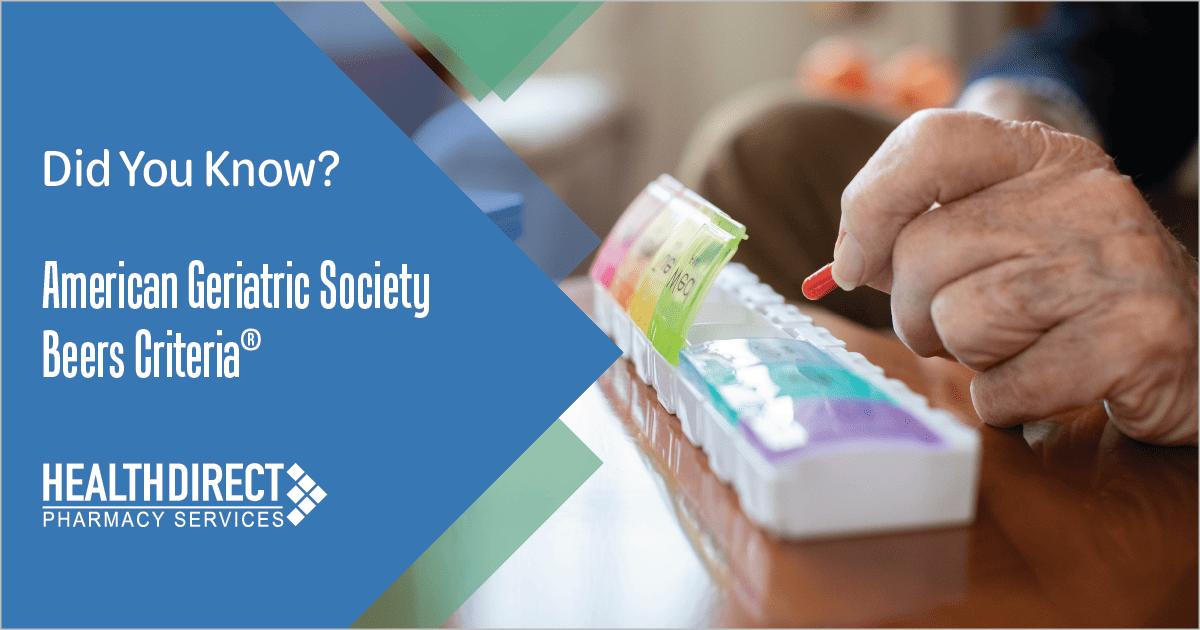About the Beers List
The American Geriatric Society (AGS) Beers Criteria® for Potentially Inappropriate Medication (PIM) Use in
Older Adults, commonly called the Beers List, serves as a comprehensive list of medications that older people may want to avoid or consider using with caution because the potential risks associated with these medications may outweigh their benefits, or safer alternatives for older adults are available.
The use of potentially inappropriate medications (PIMs) is associated with an increased risk of falls, cognitive decline, frailty, hospitalizations, and mortality. Older adults with chronic health conditions commonly require treatment with multiple medications, leading to a greater likelihood of experiencing unwanted side effects. Older people can also be more sensitive to certain types of medications through altered metabolism and body composition.
The AGS Beers Criteria provides a summary of evidence and recommendations for geriatric minded clinicians to improve the safety of therapeutic decision-making. Recommendations are intended to apply to adults 65 years and older in most care settings, with an exception for palliative and hospice care.
Which medications are included in the AGS Beers Criteria®?
The AGS Beers Criteria® describe potentially inappropriate medications where the best available evidence suggests they should be:
The AGS Beers Criteria® also identifies:
- Avoided by most older adults (Table 2)
- Avoided by older adults with specific health conditions (Table 3)
- Used with caution in most older adults (Table 4)
- Clinically important drug-drug interactions to avoid in older adults (Table 5)
- Medications to avoid or modify dose for older adults with impaired kidney function (Table 6)
- Drugs with strong anticholinergic properties (Table 7)
Applying the AGS Beers Criteria® Recommendations
| Medications in the AGS Beers Criteria® are potentially inappropriate, not definitely inappropriate. |
| Read the rationale and recommendations statements for each criterion. The caveats and guidance listed there are important. |
| Understand why medications are included in the AGS Beers Criteria® and adjust your approach to those medications accordingly. |
| Optimal application of the AGS Beers Criteria® involves identifying PIMs and, when appropriate, offering safer nonpharmacologic and pharmacologic therapies. |
| The AGS Beers Criteria® should be a starting point for a comprehensive process of identifying and improving medication appropriateness and safety. |
Notable updates to PIMS compared to previous guidelines:
- Aspirin for primary prevention has been moved to table 2, with recommendations to avoid initiating therapy and consider deprescribing in older adults.
- Updated anticoagulant recommendations; rivaroxaban and warfarin have been moved to table 2 for long-term management of VTE and nonvalvular atrial fibrillation, in favor of safer alternatives (i.e., apixaban).
- Initiation of oral and transdermal estrogen should be avoided in older women, due to an increased risk of breast cancer and blood clots. Deprescribing should be considered for older women already using nonvaginal estrogen replacement.
- Recommendation to avoid sulfonylureas has been expanded to ALL sulfonylureas, citing increased risk for CV events, all-cause mortality, and hypoglycemia.
- Caution advised (Table 4) for using SGLT-2 inhibitors in older adults due to risk of adverse events (UTI’s, diabetic ketoacidosis) with increased monitoring recommended early in treatment.
- Clinically important drug-drug interactions (Table 5) has been updated to emphasize risks of cumulative anticholinergic burden and concurrent use of multiple CNS-active medications in older adults.
REMEMBER: Potentially inappropriate medications are just that — potentially inappropriate. The AGS
Beers Criteria® is a resource, not a replacement, for the expertise and knowledge of your healthcare
provider.
Additional Resources
Published in its entirety in the Journal of the American Geriatrics Society (DOI: 10.1111/jgs.18372) the AGS Beers Criteria® is also available as a mobile app and as a pocket reference card. Both are designed to meet the needs of busy clinicians practicing in a variety of settings and are available from GeriatricsCareOnline.org.
The AGS is committed to bringing the expertise of geriatrics health professionals to the public and lay versions of the Beers Criteria® as well as tools to aid older adults and caregivers in understanding what medications are potentially inappropriate are available for free from HealthinAging.org.
References:
- 2023 American Geriatrics Society Beers Criteria® Update Expert Panel. American Geriatrics Society 2023 updated AGS Beers Criteria® for potentially inappropriate medication use in older adults. J Am Geriatr Soc. 2023; 1- 30. doi:10.1111/jgs.18372
- American Geriatrics Society. Many Older Adults Take Multiple Medications; An Updated AGS Beers Criteria® Will Help Ensure They Are Appropriate. May 4, 2023. Available from: http://ow.ly/P0Q850Og2Zf




